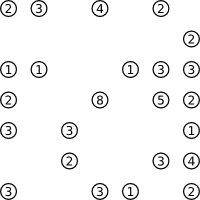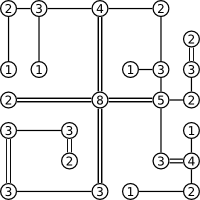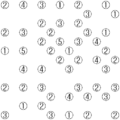Hashiwokakero facts for kids
Hashiwokakero (pronounced 'Ha-shee-wo-ka-keh-ro') is a fun logic puzzle from Japan. Its name means "build bridges!" in Japanese. This puzzle was created by a company called Nikoli.
You might also know this puzzle by other names, like Bridges or Hashi. In some countries like France and Belgium, it's called Ai-Ki-Ai. It's a game where you connect "islands" with "bridges" following special rules.
Contents
How to Play Hashiwokakero
Hashiwokakero is played on a grid, but you usually don't see the grid lines. Instead, you see circles with numbers inside them. These circles are called "islands." The numbers on the islands tell you how many bridges must connect to that island. The numbers usually range from 1 to 8.
Your main goal is to connect all the islands by drawing bridges between them. But there are some important rules you need to follow:
- Bridges must connect two different islands. They must travel in a straight line, either up, down, left, or right.
- Bridges cannot cross over other bridges or islands.
- Bridges can only go straight (horizontally or vertically), never diagonally.
- You can draw one or two bridges between any pair of islands. You cannot draw more than two.
- The number of bridges connected to each island must exactly match the number written on that island.
- All the islands must be connected together by bridges. This means you should be able to travel from any island to any other island using the bridges.
Smart Ways to Solve Hashiwokakero
Solving a Hashiwokakero puzzle is like being a detective! You use clues to figure out where to place bridges. When you place a bridge, it often helps you figure out the next move.
Starting Strong with Island Numbers
Some islands are easier to start with because their numbers give you clear clues:
- If an island has a '3' and is in a corner of the puzzle, it must have at least one bridge going in each possible direction.
- An island with a '5' along the outside edge of the puzzle also needs at least one bridge in each direction.
- If an island has a '7' anywhere in the puzzle, it must have at least one bridge going in all four directions (up, down, left, and right).
- Islands with a '4' in a corner, a '6' along an edge, or an '8' anywhere in the puzzle must have two bridges in each possible direction. This is because these numbers are so high that they need a lot of connections.
Avoiding Mistakes and Dead Ends
As you place bridges, it's a good idea to mark islands that have reached their correct number of bridges. This helps you avoid errors.
Also, remember that all islands must be connected into one big network. Be careful not to create "short circuits" or separate groups of islands. For example:
- If you have two islands with '1' on them, and they are the only two islands in a line, you usually cannot connect them. If you did, they would form a small group that couldn't connect to any other islands, unless they were the only two islands in the entire puzzle.
- Never draw a bridge that would completely cut off one group of islands from another. If you did, you would end up with two separate networks, and the puzzle requires all islands to be connected.
By using these strategies, you can solve even tricky Hashiwokakero puzzles!
Images for kids
See also





